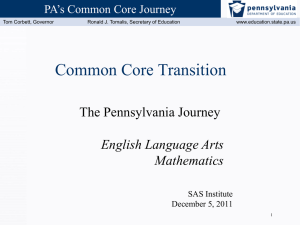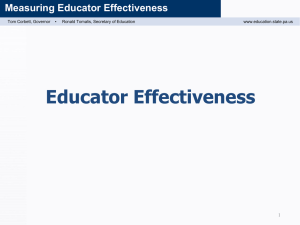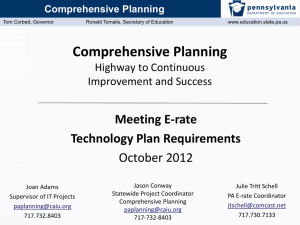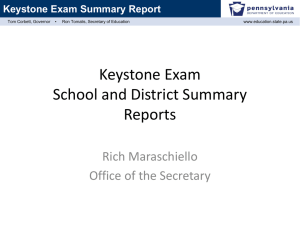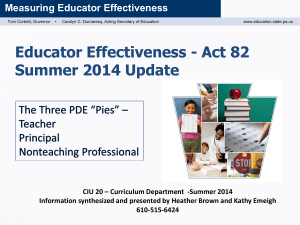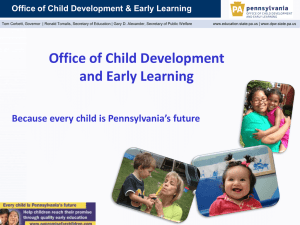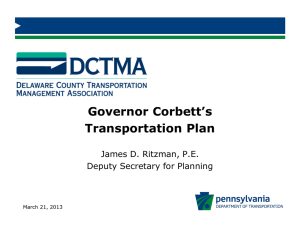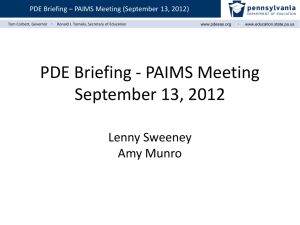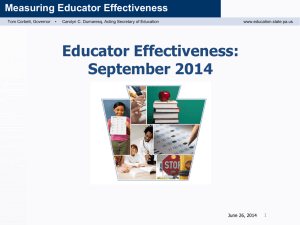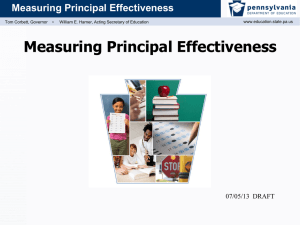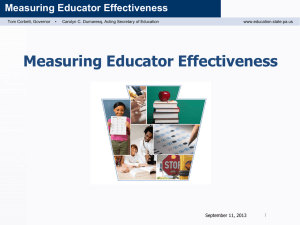Measuring Educator Effectiveness - Pennsylvania Association of
advertisement
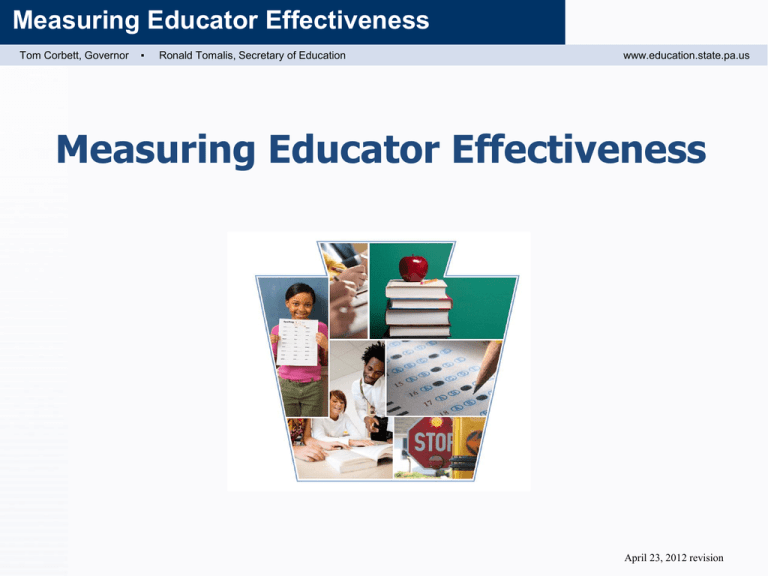
Measuring Educator Effectiveness Tom Corbett, Governor ▪ Ronald Tomalis, Secretary of Education www.education.state.pa.us Measuring Educator Effectiveness April 23, 2012 revision Measuring Educator Effectiveness Tom Corbett, Governor ▪ Ronald Tomalis, Secretary of Education www.education.state.pa.us Project Goal • To develop educator effectiveness models that will reform the way we evaluate school professionals as well as the critical components of training and professional growth. The term “educator” includes teachers, education specialists, and principals. 2 Measuring Educator Effectiveness Tom Corbett, Governor ▪ Ronald Tomalis, Secretary of Education www.education.state.pa.us Educator Effectiveness 3 Measuring Educator Effectiveness Tom Corbett, Governor ▪ Ronald Tomalis, Secretary of Education www.education.state.pa.us Background • • • • A multi-phase project that began with $800,000 Gates Foundation grant to facilitate the development of statewide policy, tools and processes to evaluate teachers and principals in which student achievement is a significant factor affecting performance ratings PDE is closely following the work of the Pittsburgh Public Schools, recipients of a $40 million Gates Foundation grant that is more comprehensive in scope but similar in redesigning evaluation policy, tools and processes A University of Pittsburgh researcher is conducting a qualitative analysis regarding the effectiveness of principal training and the comprehensiveness, validity, transparency, practicality, and quality of the teacher evaluation system A third party researcher is conducting a quantitative analysis evaluating the relationships between professional practices as measured by classroom observation scores and teacher contributions to student achievement 4 Measuring Educator Effectiveness Tom Corbett, Governor ▪ Ronald Tomalis, Secretary of Education www.education.state.pa.us 2010-2011 Phase I Sites • • • • Allentown School District Cornell School District Mohawk School District IU 5 – Northwest Tri-County 5 Measuring Educator Effectiveness Tom Corbett, Governor ▪ Ronald Tomalis, Secretary of Education www.education.state.pa.us 2011-2012 Phase II Sites • 119 Local Education Agencies, including School Districts, CTCs, Charter Schools and IUs • 363 Buildings • 658 Supervisors • 2,348 Teachers in PSSA tested subjects • 2,586 Teachers in non-PSSA tested subjects 6 Measuring Educator Effectiveness Tom Corbett, Governor ▪ Ronald Tomalis, Secretary of Education www.education.state.pa.us Danielson Framework 7 Measuring Educator Effectiveness Tom Corbett, Governor ▪ Ronald Tomalis, Secretary of Education www.education.state.pa.us Multiple Measures of Teacher Effectiveness – Observation/Evidence • Classroom observations by Principal/supervisor, including evidence that demonstrates behaviors associated with improving student achievement: – Planning and preparation, including selecting standards-based lesson goals and designing effective instruction and assessment; – Classroom environment, including establishing a culture for learning and appropriate classroom management techniques that maximize instructional time; – Instruction, including the use of research-based strategies which engage students in meaningful learning and utilize assessment results to make decisions abut student needs; and – Professional responsibilities, including using systems for managing student data and communicating with student families 8 Measuring Educator Effectiveness Tom Corbett, Governor ▪ Ronald Tomalis, Secretary of Education www.education.state.pa.us Danielson Framework, Domain 3: Instruction Component 1. Unsatisfactory 3a: Communicating with students Expectations for learning, directions and procedures, and explanations of content are unclear or confusing to students. Teacher’s use of language contains errors or is inappropriate to students’ cultures or levels of development Expectations for learning, directions and procedures, and explanations of content are Teacher’s questions are Some of the teacher’s questions elicit a thoughtful response, but 3b: Using questioning and discussion techniques low-level or inappropriate, eliciting limited student participation, and recitation rather than discussion. 2. Needs Improvement or Progressing clarified after initial confusion; teacher’s use of language is correct but may not be completely appropriate to students’ cultures or levels of development. most are low-level, posed in rapid succession. Teacher’s attempts to engage all students in the discussions are only partially successful. 3. Proficient Expectations for learning, directions and procedures, and explanations of content are clear to students. Communications are appropriate to students’ cultures and levels of development. Most of the teacher’s questions elicit a thoughtful response, and the teacher allows sufficient time for students to answer. The students are engaged and participate in the discussion, with the teacher stepping aside when appropriate. 4. Distinguished Expectations for learning, directions and procedures, and explanations of content are clear to students. Teacher’s oral and written communication is clear and expressive, appropriate to students’ cultures and levels of development, and anticipates possible student misconceptions. Questions reflect high expectations and are culturally and developmentally appropriate. Students formulate many of the highlevel questions and ensure that all voices are heard. 9 Measuring Educator Effectiveness Tom Corbett, Governor ▪ Ronald Tomalis, Secretary of Education www.education.state.pa.us Danielson Framework, Phase III • Danielson’s Framework for Teaching 2011 • PDE will identify research components that will be required of all participants • Participants may choose to rate additional components • Professional development linked to Danielson components is available on SAS 10 Measuring Educator Effectiveness Tom Corbett, Governor ▪ Ronald Tomalis, Secretary of Education www.education.state.pa.us Teacher Effectiveness System Observation/Evidence Danielson Framework Domains 1. Planning and Preparation 2. Classroom Environment 3. Instruction 4. Professional Responsibilities See Attached Rubric Building Level Data, 15% Building Level Data PSSA Achievement PVAAS Growth Graduation Rate Promotion Rate Attendance AP Course Participation SAT/PSAT Teacher Specific Data, 15% Observation/ Evidence, 50% Elective Data, 20% Teacher Specific Data PVAAS Growth Elective Data/SLOs District Designed National Tests District Rubrics IEP Growth Projects Portfolios Surveys PDE Standards for Review and Approval 11 Measuring Educator Effectiveness Tom Corbett, Governor ▪ Ronald Tomalis, Secretary of Education www.education.state.pa.us Participation Methods • Teacher Effectiveness Phase III • SIG districts with schools implementing a Transformation Model • Race to the Top Recipients 12 Measuring Educator Effectiveness Tom Corbett, Governor ▪ Ronald Tomalis, Secretary of Education www.education.state.pa.us Requirements for Phase III LEAs Implementing Teacher Effectiveness Instrument • Participating buildings and teachers are your choice • Principals/Evaluators attend IU provided training • Complete one formal observation cycle using the Danielson Framework for Teaching, 2011: preobservation conference, observation, postobservation conference • Complete one walkthrough using the form provided in training 13 Measuring Educator Effectiveness Tom Corbett, Governor ▪ Ronald Tomalis, Secretary of Education www.education.state.pa.us Phase III Requirements, continued • Rate each observed on the PDE research components • Rate each observed on any additional district options • Submit all requested data using the data collection tool(s) provided by PDE 14 Measuring Educator Effectiveness Tom Corbett, Governor ▪ Ronald Tomalis, Secretary of Education www.education.state.pa.us Requirements for SIG Districts with Transformation Model Schools • Transformation Model Schools must participate • 10% of teachers must be evaluated using teacher instrument in SY 12/13 • Principals/Evaluators must attend IU provided training • Complete one formal observation cycle using the Danielson Framework for Teaching, 2011: preobservation conference, observation, postobservation conference • Complete one walkthrough using the form provided in training 15 Measuring Educator Effectiveness Tom Corbett, Governor ▪ Ronald Tomalis, Secretary of Education www.education.state.pa.us Requirements for SIG Districts, continued • Rate each observed on the PDE research components • Rate each observed on any additional district options • Submit all requested data using the data collection tool(s) provided by PDE • Incorporate student achievement in evaluation • If your question is specific to requirements related to SIG schools, you may wish to go to the direct link: • http://www.education.state.pa.us/portal/server.pt/comm unity/federal_programs/7374/school_improvement_grant _%28sig%29/797379 16 Measuring Educator Effectiveness Tom Corbett, Governor ▪ Ronald Tomalis, Secretary of Education www.education.state.pa.us Requirements for Race to the Top • Race to the Top recipient participation is district-wide • Achieve performance measures as outlined in grant agreement • Principals/Evaluators must attend training • Complete one formal observation cycle • Complete one walkthrough using the form provided in training • Submit all requested data using the data collection tool(s) provided by PDE • Incorporate student achievement in evaluation 17 Measuring Educator Effectiveness Tom Corbett, Governor ▪ Ronald Tomalis, Secretary of Education www.education.state.pa.us Requirements for Race to the Top, continued • Do NOT sign up for RTTT if you’re not implementing an evaluation system • If you like the Effectiveness project but are uncertain about RTTT commitments – You can participate in Phase 3 without committing to RTTT • For more information on Race to the Top you may wish to go to the following URL: – http://www.portal.state.pa.us/portal/server.pt/comm unity/american_recovery_and_reinvestment_act/176 96/race_to_the_top/1066062 18 Measuring Educator Effectiveness Tom Corbett, Governor ▪ Ronald Tomalis, Secretary of Education www.education.state.pa.us Educational Specialist Effectiveness 19 Measuring Educator Effectiveness Tom Corbett, Governor ▪ Ronald Tomalis, Secretary of Education www.education.state.pa.us Who are Educational Specialists? • • • Educational Specialists are defined in Pennsylvania School Code with the scope of their certificates and assignments described in Certification and Staffing Polices and Guidelines (CSPGs). Currently CSPG 75 through 81 list the following specialist certifications: – Dental Hygienist – Elementary School Counselor – Home and School Visitor – Instructional Technology Specialist – Secondary School Counselor – School Nurse – School Psychologist PDE is in the process of working with stakeholder groups from across the Commonwealth to revise the Danielson Framework for Teaching to reflect the specific roles and functions of the identified specialist groups 20 Measuring Educator Effectiveness Tom Corbett, Governor ▪ Ronald Tomalis, Secretary of Education www.education.state.pa.us Specialists-What about other licensed staff hired under teacher contracts? • Given that many LEAs hire licensed professionals under teacher contracts who are not certificated as specialists under Pennsylvania School Code, PDE has made a decision to develop revised Danielson Framework for Teaching rubrics for the following roles: – Occupational Therapist – Physical Therapist – Social Workers – Behavior Analysts – Educational Interpreters • PDE is in the process of working with stakeholder groups from across the Commonwealth to revise the Danielson Framework for Teaching to reflect the specific roles and functions of the identified licensed professionals. 21 Measuring Educator Effectiveness Tom Corbett, Governor ▪ Ronald Tomalis, Secretary of Education www.education.state.pa.us Principal Effectiveness 22 Measuring Educator Effectiveness Tom Corbett, Governor ▪ Ronald Tomalis, Secretary of Education www.education.state.pa.us Principal Effectiveness Domain 1 - Strategic/Cultural Leadership : The school leader will systematically and collaboratively develop a positive culture to promote continuous student growth and staff development. The leader articulates and models a clear vision of the school’s culture that involves students, families, and staff. Domain 2- Managerial Leadership: The school leader will ensure that the school has processes and systems in place for budgeting, staffing, problem solving, communicating expectations and scheduling that result in organizing the work routines in the building. The school leader must efficiently, effectively, and safely manage the building to foster staff accountability and student achievement. 23 Measuring Educator Effectiveness Tom Corbett, Governor ▪ Ronald Tomalis, Secretary of Education www.education.state.pa.us Principal Effectiveness Domain 3 – Leadership for Learning: The school leader assures school-wide conversations occur regarding standards for curriculum, instruction, assessment, and data on student learning based on research and best practices, and ensures that the ideas developed are integrated into the school’s curriculum and instructional approaches. Domain 4 – School and Community Leadership: The school leader will promote the success of all students, the positive interactions among building stakeholders, and the professional growth of staff by acting with integrity, fairness and in an ethical manner. 24 Measuring Educator Effectiveness Tom Corbett, Governor ▪ Ronald Tomalis, Secretary of Education www.education.state.pa.us 25 Measuring Educator Effectiveness Tom Corbett, Governor ▪ Ronald Tomalis, Secretary of Education www.education.state.pa.us Future Plans 26 Measuring Educator Effectiveness Tom Corbett, Governor ▪ Ronald Tomalis, Secretary of Education www.education.state.pa.us The “Elective” Portion of Teacher Effectiveness Measuring Student Performance for Teachers in Tested and Non‐Tested Grades and Subjects 27 Measuring Educator Effectiveness Tom Corbett, Governor ▪ Ronald Tomalis, Secretary of Education www.education.state.pa.us Teacher Effectiveness System Observation/Evidence Danielson Framework Domains 1. Planning and Preparation 2. Classroom Environment 3. Instruction 4. Professional Responsibilities See Attached Rubric Building Level Data, 15% Building Level Data PSSA Achievement PVAAS Growth Graduation Rate Promotion Rate Attendance AP Course Participation SAT/PSAT Teacher Specific Data, 15% Observation/ Evidence, 50% Elective Data, 20% Teacher Specific Data PVAAS Growth Elective Data/SLOs District Designed National Tests District Rubrics IEP Growth Projects Portfolios Surveys PDE Standards for Review and Approval 28 Measuring Educator Effectiveness Tom Corbett, Governor ▪ Ronald Tomalis, Secretary of Education www.education.state.pa.us Additional Items • • • • Inter-Rater Reliability Professional Development Alternative Educator Effectiveness System Implementation Guidelines – Formula – Differentiated Supervision – Other 29 Measuring Educator Effectiveness Tom Corbett, Governor ▪ Ronald Tomalis, Secretary of Education www.education.state.pa.us The deadline to complete and submit your eGrants application for RACE TO THE TOP is noon on Friday, May 11, 2012 30 Measuring Educator Effectiveness Tom Corbett, Governor ▪ Ronald Tomalis, Secretary of Education www.education.state.pa.us The deadline for everyone to commit to PHASE III is May 31, 2012. https://www.surveymonkey.com/s/S5K8RYR 31 Measuring Educator Effectiveness Tom Corbett, Governor ▪ Ronald Tomalis, Secretary of Education www.education.state.pa.us This PowerPoint Presentation can be found at http://www.portal.state.pa.us/portal/server.pt/com munity/newsroom/7234/page/1034646 We will post answers to questions posed during this webinar to this webpage that is dedicated to the Teacher Effectiveness Project. Measuring Educator Effectiveness Tom Corbett, Governor ▪ Ronald Tomalis, Secretary of Education www.education.state.pa.us 33
